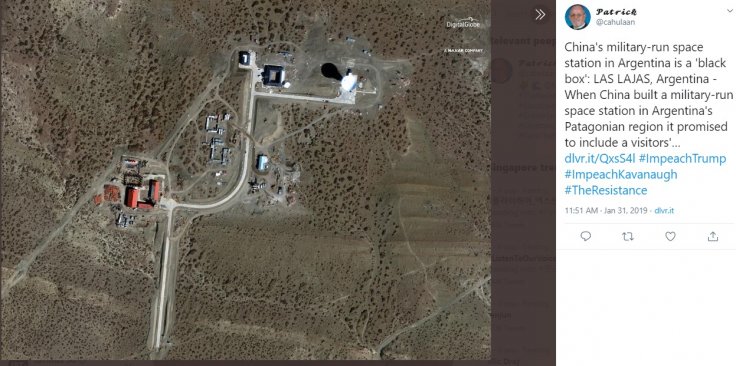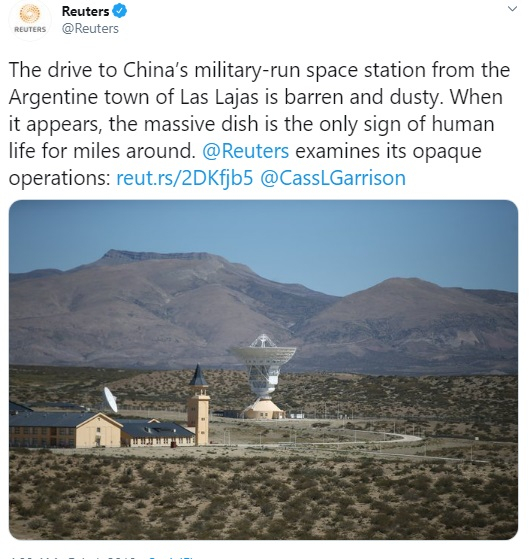Beijing and Argentina had come to an agreement to build a 16-story powerful antenna in the Patagonian region. The deep-space station in the region is now built—behind the eight-foot barbed wire fence which surrounds the entire space station compound. Even though it was claimed that the aim of this facility is for peaceful space observation, experts are worried about its potential use for wrong reasons.
The space center at the Patagonian region—an area encompassing the vast southernmost tip of South America—has caused worries among many, including the Donald Trump Administration due to its ties with the Chinese military.
Experts have warned that the agreement between both the countries obliges Beijing to inform the South American country about its activities at the station, but provides no enforcement mechanism for the authorities to ensure that it is not being used for military work.

Agreement Doesn't Matter
According to interviews with dozens of residents, current as well as former Argentine government officials, U.S. officials, satellite and astronomy specialists and legal experts, the true purpose of the facility is still suspicious.
An Argentine lawyer Juan Uriburu, who worked on two major China-Argentina collaboration, said that "it really doesn't matter" what a contract or agreement says, and "how do you make sure they play by the rules?"
"I would say that, given that one of the actors involved in the agreements reports directly to the Chinese military, it is at least intriguing to see that the Argentine government did not deal with this issue with greater specificity," he added.
Early reports claimed that according to hundreds of pages of Argentine government documents, the huge compound in the Patagonian region operates with little oversight by the Argentine authorities. Former Argentine foreign minister, Susana Malcorra, previously in an interview said that the country has no physical oversight of the station's operations. In 2016, she revised the space station deal to include a stipulation that it be for civilian use only.
For 'Peaceful Use'
China Satellite Launch and Tracking Control General (CLTC) is responsible for managing the station but it cannot be overlooked that ultimately the CLTC reports to the PLA Strategic Support Force.
Beijing claimed that its space program is for peaceful purpose. The Chinese foreign ministry clearly mentioned in a statement that the Argentina based station is only for civilian use and it is open to the public as well as media. Argentina's space agency CONAE claimed that the deal between the two countries stated their commitment to "peaceful use" of the project in the Patagonian region.
But experts are concerned about the facility. If the Chinese authorities want, they can easily hide illegitimate data in these transmissions or add encrypted channels to the frequencies, after an agreement with Argentina.
Not Science but a Spying Facility

The U.S. has long raised concerns about what it sees as China's apparent plan to "militarize" space. As per the U.S. officials, there are reasons to be skeptical about Beijing's true intentions in the base.
Garrett Marquis, spokesman for the White House National Security Council said that the station in Argentina is another example of "opaque and predatory Chinese dealings that undermine the sovereignty of host nations."
The director of the U.S. National Radio Astronomy Observatory, Tony Beasley claimed that this facility could "listen" to other governments' satellites, and collect sensitive data, even though such work could be done using less sophisticated equipment.
Not A Sinister Plan?
Beasley also said that anyone is capable of doing such kind of spying, even "I can do that with a dish in my back yard, basically." In addition, he said, "I don't know that there's anything particularly sinister or troubling about any part of China's space radio network in Argentina."
The officials of Argentina have been defending the facility while claiming that the agreement is similar to the deal, they signed with the European Space Agency to build a station in a neighboring province.
As per Uriburu, who reviews the document of the agreement, "All of the ESA governments play by democratic rules. The party is not the state. But that's not the case in China. The party is the state."
In the U.S., NASA and the military—which has its own space command for missions—have collaborated in some instances, said Jonathan McDowell, who is an astronomer at the Harvard-Smithsonian Center for Astrophysics. He said, "The line [between NASA and U.S. military] does blur sometimes, but that's very much the exception."
Local Residents are Concerned

Alfredo Garrido, 51, a local shop owner said that the authorities at the station don't allow people to get inside and no one can see what is going on in the field. "My opinion is that it is not a scientific research base, but rather a Chinese military base," claimed Garrido who lives in Las Lajas—a town which is located about 40 minutes' drive from where the antenna was built.
Meeting Chinese General
A 60-year-old man, Alberto Hugo Amarilla local hotel owner told Reuters about a dinner he attended shortly after construction of the massive antenna began at the site and remembered meeting a Chinese official who was a Chinese general.
As per reports, here are conspiracies that the science facility has been used to make nuclear bombs. This suspicious station began the operation in April 2020 and includes at least 30 Chinese workers. But there are no local employees working at the station, claimed Las Lajas mayor, Maria Espinosa, who also said that the facility has been good for the local economy.
However, according to local residents, they hardly have seen people from the station in Las Lajas, except when the employees make a trip to the Chinese supermarket in the area. But Espinosa said she rented her house to the station workers before they moved to the base, and she also visited the site at least eight times. CONAE also claimed that students from nearby towns have already visited the facility.
A local government official earlier showed a list of local journalists who visited the station to Reuters, but it was noticed that all of them visited on a particular day—2017 February—almost 14 months before it became operational.









